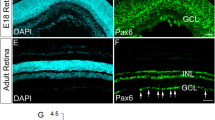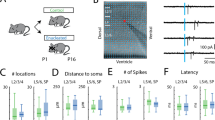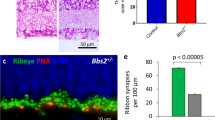Abstract
In the vertebrate retina, establishment of precise synaptic connections among distinct retinal neuron cell types is critical for processing visual information and for accurate visual perception. Retinal ganglion cells (RGCs), amacrine cells and bipolar cells establish stereotypic neurite arborization patterns to form functional neural circuits in the inner plexiform layer (IPL)1,2,3, a laminar region that is conventionally divided into five major parallel sublaminae1,2. However, the molecular mechanisms governing distinct retinal subtype targeting to specific sublaminae within the IPL remain to be elucidated. Here we show that the transmembrane semaphorin Sema6A signals through its receptor PlexinA4 (PlexA4) to control lamina-specific neuronal stratification in the mouse retina. Expression analyses demonstrate that Sema6A and PlexA4 proteins are expressed in a complementary fashion in the developing retina: Sema6A in most ON sublaminae and PlexA4 in OFF sublaminae of the IPL. Mice with null mutations in PlexA4 or Sema6A exhibit severe defects in stereotypic lamina-specific neurite arborization of tyrosine hydroxylase (TH)-expressing dopaminergic amacrine cells, intrinsically photosensitive RGCs (ipRGCs) and calbindin-positive cells in the IPL. Sema6A and PlexA4 genetically interact in vivo for the regulation of dopaminergic amacrine cell laminar targeting. Therefore, neuronal targeting to subdivisions of the IPL in the mammalian retina is directed by repulsive transmembrane guidance cues present on neuronal processes.
This is a preview of subscription content, access via your institution
Access options
Subscribe to this journal
Receive 51 print issues and online access
$199.00 per year
only $3.90 per issue
Buy this article
- Purchase on Springer Link
- Instant access to full article PDF
Prices may be subject to local taxes which are calculated during checkout




Similar content being viewed by others
Change history
10 February 2011
Three labels were corrected in Fig. 4.
References
Wassle, H. Parallel processing in the mammalian retina. Nature Rev. Neurosci. 5, 747–757 (2004)
Sanes, J. R. & Zipursky, S. L. Design principles of insect and vertebrate visual systems. Neuron 66, 15–36 (2010)
Huberman, A. D., Clandinin, T. R. & Baier, H. Molecular and cellular mechanisms of lamina-specific axon targeting. Cold Spring Harb Perspect Biol 2, a001743 (2010)
Yamagata, M., Weiner, J. A. & Sanes, J. R. Sidekicks: synaptic adhesion molecules that promote lamina-specific connectivity in the retina. Cell 110, 649–660 (2002)
Yamagata, M. & Sanes, J. R. Dscam and Sidekick proteins direct lamina-specific synaptic connections in vertebrate retina. Nature 451, 465–469 (2008)
Fuerst, P. G., Koizumi, A., Masland, R. H. & Burgess, R. W. Neurite arborization and mosaic spacing in the mouse retina require DSCAM. Nature 451, 470–474 (2008)
Fuerst, P. G., Harris, B. S., Johnson, K. R. & Burgess, R. W. A novel null allele of mouse DSCAM survives to adulthood on an inbred C3H background with reduced phenotypic variability. Genesis 48, 578–584 (2010)
Tran, T. S., Kolodkin, A. L. & Bharadwaj, R. Semaphorin regulation of cellular morphology. Annu. Rev. Cell Dev. Biol. 23, 263–292 (2007)
Leighton, P. A. et al. Defining brain wiring patterns and mechanisms through gene trapping in mice. Nature 410, 174–179 (2001)
de Winter, F., Cui, Q., Symons, N., Verhaagen, J. & Harvey, A. R. Expression of class-3 semaphorins and their receptors in the neonatal and adult rat retina. Invest. Ophthalmol. Vis. Sci. 45, 4554–4562 (2004)
Yaron, A., Huang, P. H., Cheng, H. J. & Tessier-Lavigne, M. Differential requirement for Plexin-A3 and -A4 in mediating responses of sensory and sympathetic neurons to distinct class 3 Semaphorins. Neuron 45, 513–523 (2005)
Gu, C. et al. Neuropilin-1 conveys semaphorin and VEGF signaling during neural and cardiovascular development. Dev. Cell 5, 45–57 (2003)
Giger, R. J. et al. Neuropilin-2 is required in vivo for selective axon guidance responses to secreted semaphorins. Neuron 25, 29–41 (2000)
Famiglietti, E. V., Jr & Kolb, H. Structural basis for ON- and OFF-center responses in retinal ganglion cells. Science 194, 193–195 (1976)
Viney, T. J. et al. Local retinal circuits of melanopsin-containing ganglion cells identified by transsynaptic viral tracing. Curr. Biol. 17, 981–988 (2007)
Zhang, D. Q. et al. Intraretinal signaling by ganglion cell photoreceptors to dopaminergic amacrine neurons. Proc. Natl Acad. Sci. USA 105, 14181–14186 (2008)
Hattar, S., Liao, H. W., Takao, M., Berson, D. M. & Yau, K. W. Melanopsin-containing retinal ganglion cells: architecture, projections, and intrinsic photosensitivity. Science 295, 1065–1070 (2002)
Pires, S. S. et al. Differential expression of two distinct functional isoforms of melanopsin (Opn4) in the mammalian retina. J. Neurosci. 29, 12332–12342 (2009)
Suto, F. et al. Interactions between plexin-A2, plexin-A4, and semaphorin 6A control lamina-restricted projection of hippocampal mossy fibers. Neuron 53, 535–547 (2007)
Stacy, R. C. & Wong, R. O. Developmental relationship between cholinergic amacrine cell processes and ganglion cell dendrites of the mouse retina. J. Comp. Neurol. 456, 154–166 (2003)
Kay, J. N. et al. Transient requirement for ganglion cells during assembly of retinal synaptic layers. Development 131, 1331–1342 (2004)
Runker, A. E., Little, G. E., Suto, F., Fujisawa, H. & Mitchell, K. J. Semaphorin-6A controls guidance of corticospinal tract axons at multiple choice points. Neural Develop. 3, 34 (2008)
Kerjan, G. et al. The transmembrane semaphorin Sema6A controls cerebellar granule cell migration. Nature Neurosci. 8, 1516–1524 (2005)
Yoshida, Y., Han, B., Mendelsohn, M. & Jessell, T. M. PlexinA1 signaling directs the segregation of proprioceptive sensory axons in the developing spinal cord. Neuron 52, 775–788 (2006)
Cheng, H. J. et al. Plexin-A3 mediates semaphorin signaling and regulates the development of hippocampal axonal projections. Neuron 32, 249–263 (2001)
Friedel, R. H. et al. Plexin-B2 controls the development of cerebellar granule cells. J. Neurosci. 27, 3921–3932 (2007)
Pasterkamp, R. J., Peschon, J. J., Spriggs, M. K. & Kolodkin, A. L. Semaphorin 7A promotes axon outgrowth through integrins and MAPKs. Nature 424, 398–405 (2003)
Suto, F. et al. Plexin-a4 mediates axon-repulsive activities of both secreted and transmembrane semaphorins and plays roles in nerve fiber guidance. J. Neurosci. 25, 3628–3637 (2005)
Rodieck, R. W. The density recovery profile: a method for the analysis of points in the plane applicable to retinal studies. Vis. Neurosci. 6, 95–111 (1991)
Rockhill, R. L., Euler, T. & Masland, R. H. Spatial order within but not between types of retinal neurons. Proc. Natl Acad. Sci. USA 97, 2303–2307 (2000)
Acknowledgements
We thank K.-W. Yau for the C-terminal melanopsin antibody, F. Suto for the PlexA4 antibody, B. Howell for the Dab-1 antibody, Y. Yoshida for the PlexA1−/− eyes, P. Mombaerts for the PlexB1−/− and PlexB3−/− mice (unpublished), C. Gu for the PlexD1-/flox ;nestin cre (unpublished) eyes and M. Tessier-Lavigne for the PlexA4−/− mice. We also thank J. Nathans, S. Hattar, K. Mandai and M. Riccomagno for comments on the manuscript and discussions, and members of the Kolodkin laboratory for assistance. This work was supported by R01 NS35165 to A.L.K., a predoctoral fellowship from the Nakajima Foundation to R.L.M., the Fondation pour la Recherche Médicale (Programme équipe FRM) to A.C., the Fondation Retina France to K.T.N.-B.-C., and a PhD fellowship from the Paris School of Neuroscience (ENP) to A.P. A.L.K. is an investigator of the Howard Hughes Medical Institute.
Author information
Authors and Affiliations
Contributions
R.L.M., A.C. and A.L.K. conceived and designed the experiments; R.L.M. performed most of the experiments and data analysis; K.T.N.-B.-C., A.P. and A.C. participated in the phenotypic analyses of Sema6A mutant mice and provided PlexA2−/− and PlexB2−/− mutants; T.C.B. performed cholera toxin injections and provided suggestions and reagents; R.L.M. and A.L.K. wrote the paper.
Corresponding author
Ethics declarations
Competing interests
The authors declare no competing financial interests.
Supplementary information
Supplementary Information
The file contains Supplementary Figures 1-13 with legends and Supplementary References. (PDF 14489 kb)
Rights and permissions
About this article
Cite this article
Matsuoka, R., Nguyen-Ba-Charvet, K., Parray, A. et al. Transmembrane semaphorin signalling controls laminar stratification in the mammalian retina. Nature 470, 259–263 (2011). https://doi.org/10.1038/nature09675
Received:
Revised:
Accepted:
Published:
Issue Date:
DOI: https://doi.org/10.1038/nature09675
This article is cited by
-
Retinal ganglion cell repopulation for vision restoration in optic neuropathy: a roadmap from the RReSTORe Consortium
Molecular Neurodegeneration (2023)
-
Assembly and maintenance of GABAergic and Glycinergic circuits in the mammalian nervous system
Neural Development (2018)
-
Strategies for assembling columns and layers in the Drosophila visual system
Neural Development (2018)
-
Tbr1 instructs laminar patterning of retinal ganglion cell dendrites
Nature Neuroscience (2018)
-
Semaphorin-Plexin signaling influences early ventral telencephalic development and thalamocortical axon guidance
Neural Development (2017)
Comments
By submitting a comment you agree to abide by our Terms and Community Guidelines. If you find something abusive or that does not comply with our terms or guidelines please flag it as inappropriate.



